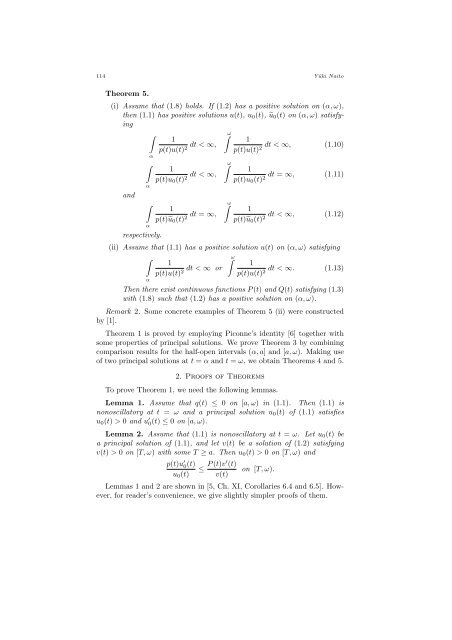REMARKS ON SINGULAR STURM COMPARISON THEOREMS
REMARKS ON SINGULAR STURM COMPARISON THEOREMS
REMARKS ON SINGULAR STURM COMPARISON THEOREMS
Create successful ePaper yourself
Turn your PDF publications into a flip-book with our unique Google optimized e-Paper software.
114 Yūki Naito<br />
Theorem 5.<br />
(i) Assume that (1.8) holds. If (1.2) has a positive solution on (α, ω),<br />
then (1.1) has positive solutions u(t), u 0 (t), ũ 0 (t) on (α, ω) satisfying<br />
and<br />
∫<br />
α<br />
∫<br />
α<br />
∫<br />
α<br />
respectively.<br />
α<br />
ω<br />
1<br />
dt < ∞,<br />
p(t)u(t)<br />
2<br />
ω<br />
1<br />
dt < ∞,<br />
p(t)u 0 (t)<br />
2<br />
ω<br />
1<br />
dt = ∞,<br />
p(t)ũ 0 (t)<br />
2<br />
∫<br />
∫<br />
∫<br />
1<br />
dt < ∞, (1.10)<br />
p(t)u(t)<br />
2<br />
1<br />
dt = ∞, (1.11)<br />
p(t)u 0 (t)<br />
2<br />
1<br />
dt < ∞, (1.12)<br />
p(t)ũ 0 (t)<br />
2<br />
(ii) Assume that (1.1) has a positive solution u(t) on (α, ω) satisfying<br />
∫<br />
∫ω<br />
1<br />
1<br />
dt < ∞ or<br />
dt < ∞. (1.13)<br />
p(t)u(t)<br />
2<br />
p(t)u(t)<br />
2<br />
Then there exist continuous functions P (t) and Q(t) satisfying (1.3)<br />
with (1.8) such that (1.2) has a positive solution on (α, ω).<br />
Remark 2. Some concrete examples of Theorem 5 (ii) were constructed<br />
by [1].<br />
Theorem 1 is proved by employing Piconne’s identity [6] together with<br />
some properties of principal solutions. We prove Theorem 3 by combining<br />
comparison results for the half-open intervals (α, a] and [a, ω). Making use<br />
of two principal solutions at t = α and t = ω, we obtain Theorems 4 and 5.<br />
2. Proofs of Theorems<br />
To prove Theorem 1, we need the following lemmas.<br />
Lemma 1. Assume that q(t) ≤ 0 on [a, ω) in (1.1). Then (1.1) is<br />
nonoscillatory at t = ω and a principal solution u 0 (t) of (1.1) satisfies<br />
u 0 (t) > 0 and u ′ 0(t) ≤ 0 on [a, ω).<br />
Lemma 2. Assume that (1.1) is nonoscillatory at t = ω. Let u 0 (t) be<br />
a principal solution of (1.1), and let v(t) be a solution of (1.2) satisfying<br />
v(t) > 0 on [T, ω) with some T ≥ a. Then u 0 (t) > 0 on [T, ω) and<br />
p(t)u ′ 0(t)<br />
u 0 (t)<br />
≤ P (t)v′ (t)<br />
v(t)<br />
on [T, ω).<br />
Lemmas 1 and 2 are shown in [5, Ch. XI, Corollaries 6.4 and 6.5]. However,<br />
for reader’s convenience, we give slightly simpler proofs of them.

















